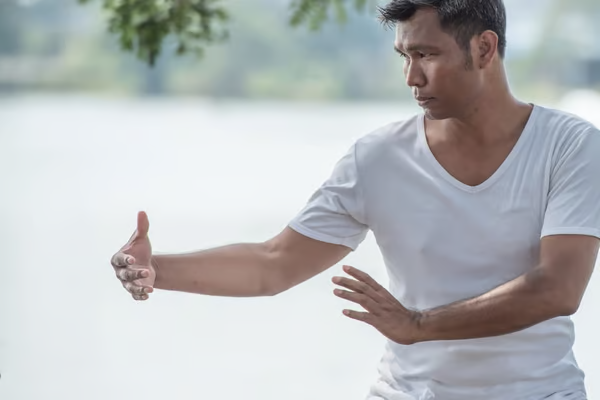
The Difference between Qigong and Tai Chi
Sep 23, 2021Sarah Divine here, a senior White Tiger Qigong instructor. Today I will tell you a little bit about the differences between Qigong and Tai Chi. What I find really interesting is when I'm speaking to people about Qigong, I ask them if they have heard of it, and they usually haven't. So, then I say, "Well, have you heard of Tai Chi?" Almost everybody says 'yes'. The funny thing is that Tai Chi is actually a form of Qigong. We will discuss the difference between Qigong and Tai Chi thoroughly in this post. Qigong has a really ancient history. It stems back over 5000 years to the shamanic Wu people in China. Amongst the major branches of Qigong, we have Spiritual Qigong, Medical Qigong, and Martial Qigong.
What is the difference between Qigong and Tai Chi?
The type of Qigong that I practice is Taoist Medical Qigong, so White Tiger Qigong is a Taoist Medical Qigong practice. Tai Chi, on the other hand, is actually a form of Martial Qigong. It was said that Tai Chi originated over 700 years ago, although some people think it was even earlier than that. I am familiar with Chen Style, the Wu style, and the Yang Style. I'm not personally able to do them all, but I've just heard of them, and there are a few more styles of Tai Chi out there.
I actually personally practiced a little bit of Yang Style Qigong 19 years ago, when I first came to Australia, and then again in 2015 for a short while. But I let that practice go when I discovered White Tiger Qigong. With this, I can speak from a little bit of experience, but not much. Nevertheless, I can tell you something about the similarities and the differences between Qigong and Tai Chi practices.
What makes Tai Chi different from Qigong?

I think it's useful to understand what the term Tai Chi actually means. It roughly translates as the 'supreme ultimate' or the 'grand ultimate' in English. This represents the conditional state from which the principle of Yin and Yang evolves. Now, the Yin and Yang principle is very important to both Qigong and Tai Chi. It is the interrelationship between the union of opposites. You see it, for example, in the understanding of the nature of heat versus cold or rising versus sinking. The lower aspect of the body versus the upper, the internal versus the external. All of this is represented by the principle of Yin and Yang. And there are other principles that are indeed similar within the two practices. However, there are a number of things that are quite different. So, let's just check in with what White Tiger Qigong is, relevant to Tai Chi.
This beautiful Qigong is a Taoist Medical Qigong, and we use it for healing purposes and for attaining or maintaining health. Additionally, this Qigong aids us to go beyond our current state of health into a transformational phase, which then helps us to achieve our maximum human potential. Tai Chi as a martial art - with a martial application - is used for fighting and it has the elements of blocking or striking. So, you need to internalize or discharge energy through this particular way of practicing Tai Chi.
There are also more modern versions of Tai Chi which are practiced for health applications. But these are fundamentally quite different from the kind of Qigong that I practice. Tai Chi as a health Qigong teaches you to relax in your movement to achieve a gentle flow state. So, you're getting a nice opening of your joints, and increasing your range of motion, while you're working on stabilizing through the legs and the feet. You are especially enhancing your appropriate receptive awareness and working on the breathing mechanism to improve your rest and digest response, so being able to attenuate the stress response and increase the relaxation response. This we see in White Tiger Qigong, and more.
In Taoist Medical Qigong, we're always seeking to gently expand the range of motion through our targeted compression, contraction, and expansion movements. We also squeeze out the organs like a sponge, and we wring out our meridians like towels. This, all together combined with how you use your breath, is a very profound, very deep detoxification process. And it also really helps with emotional balance. For me personally, I've found that that delving deeper into this Qigong has given me more lasting benefits than the experience I had practicing Tai Chi.
Now, that's not to say that it's not going to work for you. It's just I think, for me, this was a much deeper, more integrated method to really enhance health and well-being. That being said, let's have a look at some of the principles and differences in a little bit greater detail to help you to make up your mind.
Further comparisons
Difference between Qigong and Tai Chi in pulsation
Pulsation is different between Qigong and Tai Chi. Let's look for instance at 5 Animal Qigong in the White Tiger Qigong Trinity system. In these forms, we pulse through the meridians, the organs, and acupressure points, and we do this by moving through tension to relaxation. This is quite different to the Tai Chi principle in Yang Style Tai Chi of moving into complete relaxation. In 5 Element Qigong, we execute movement on the principle of moving into maximum expansion, breath-holding, then relaxation. So, we're getting deep rhythmic squeezing-out of our organs and deep ringing-out of our meridians, like a towel. It can be seen that we can't just apply a blanket principle of one-size-fits-all to both of these practices.
Crown Point suspended to the sky
So, the first principle we're looking at in Tai Chi is keeping the Crown Point suspended to the sky. And in Qigong, we indeed do this in many of the practices, especially the standing Qigong, however, it's not one-size-fits-all. For example, in Leopard Qigong and Snake Qigong, we bend over deeply to the side, getting a deep lateral stretch, and the head stays in alignment with the axis - with the spine - rather than aligning the Crown Point to the sky.

Chest hollow, back long
In Tai Chi, the chest is kept hollow, or slightly concave, while the back is long. Again, this is something that you'll see in the standing Qigong - or Zhang Zhuang - practice, in Taoist medical Qigong. However, there are many instances where we actually pulse through the chest; we're doing this to really break through stagnant Qi and develop a deep sort of rhythmic tension-to-relaxation response in the organs. We do this, for example, in the chest during Tiger; you'll see that there's a sinking motion as you go into the pushing-forwards phase. Then as you come back and you open up the chest, you pulse into the breastbone at the middle Dan Tian, and you expand the chest, hence the tension to relaxation effect.
Shoulder relaxed, elbows soft
In Tai Chi in terms of the shoulders, you relax them, keeping them soft, and keeping the elbows soft. However, in Taoist Medical Qigong, while certainly being something you do in your standing meditation practice, we often break through stagnation by pulsing through the shoulders during dynamic practice.
In the Crane movements, for instance, in 5 Animal Qigong, and also in 5 Element Qigong, there's a significant degree of pulsing through the shoulder area to actually break through stagnation.
Waist relaxed
Going down to the waist, the waist should stay relaxed in your Tai Chi practice. This is quite typical for a lot of forms in White Tiger Qigong, but there are also a lot of instances where we move the pelvis, rolling it forward and back. Again, we're getting that rhythmic pulsing through the lower body and through the waist area to expand and contract and help to send Qi outwards, to the periphery and through the rest of the torso.
Differentiate between empty leg and support leg
This is one of the principles which is true of both Tai Chi and Qigong. We differentiate between the empty leg, the leg that's not really bearing the weight, and the support leg, which is holding most of the force in both of these practices. In both practices.
Use the mind 'Yi' to guide the Qi
In White Tiger Qigong as well as Tai Chi we use the mind, tapping into our intention spirit - our Yi -, to guide Qi. This is a really important component of both of these practices.
Unite upper and lower body
Tai Chi seeks to unite the upper body and the lower body, and this is a similar principle in White Tiger Qigong.
Continuity without interruption
This another important aspect of Tai Chi and is true for some of our White Tiger Qigong. For instance, in 8 Trigram Organ Qigong there is an effortless flow from one form to the next. However, in other forms like 5 Element Qigong, we come from a stop-and-go principle. So, there is flow, but the rhythm is created through stopping and then starting again. The stop is at the peak of a deep inhalation and a deep expansion. Then you contract out of that on the exhalation and move back to your baseline stance. This is super, super important for generating Qi flow - for really opening up the flow of Qi to the organs and meridians.
Stillness in movement
Finally, in both Tai Chi and White Tiger Qigong, we seek stillness in the movement. So, you can say this is a fundamental principle of Taoist Qigong, as well as Tai Chi.
Why White Tiger Qigong?
You can see that there are indeed some similarities, but there are a lot of clear differences between Tai Chi and Taoist Medical Qigong. As I said, you really need to consider what it is you're trying to get out of your practice if you are trying to decide which practice to adopt. For longevity, for healing, for health, for maximum human potential, I have been really blown away time and again by White Tiger Qigong as a Taoist, medical Qigong practice, and what it's doing for me on many levels of my being - physiologically, emotionally, mentally, physically, and spiritually. I'm 55 years old and I really can say that I've never felt better. I feel more balanced in my emotions, in my mind, and am mentally sharper, and more physically adept as well. I'm hopefully a better and kinder human being for it, too.
Ultimately, I enjoy life more from having taken up this practice. And so that's what I can give you in this discussion. I did enjoy practicing Tai Chi as well. So please don't rule it out as an option. If it's something you love, I'm not looking to argue about it. I recommend going out there and exploring, to find out for yourself what is right for you. Hopefully, I've given you some useful pointers that will help you on this journey of discovery.



